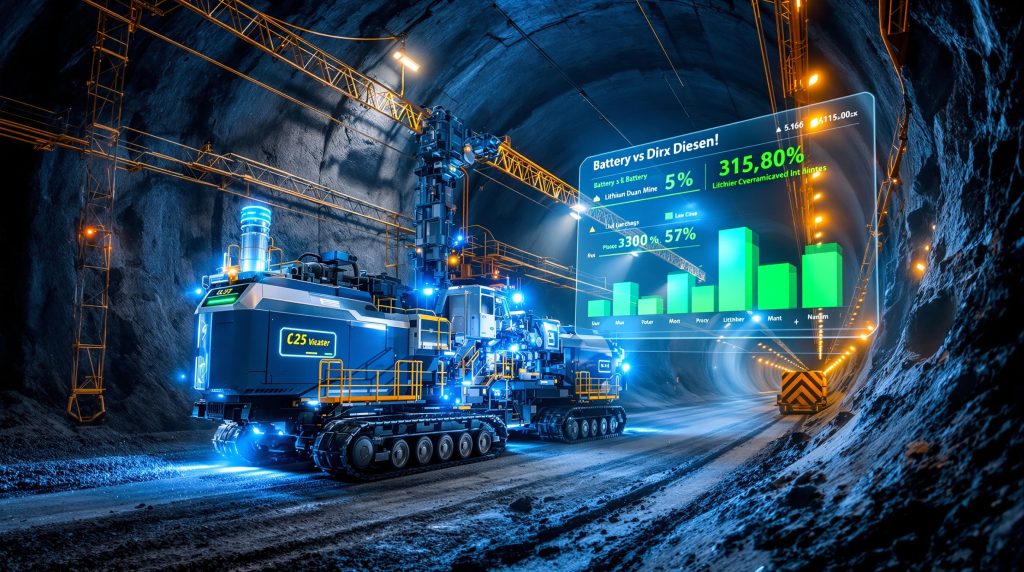What Makes Battery-Electric Jumbos Essential for Modern Mining?
Underground mining operations worldwide are experiencing a fundamental shift toward electrification, with battery-electric jumbo leading this transformation. These powerful drilling machines represent the convergence of environmental responsibility, operational efficiency, and technological advancement in the extractive industries.
According to the International Council on Mining & Metals (ICMM) 2023 report on industry decarbonisation, mining companies worldwide have increased electric equipment procurement by approximately 35-40% between 2020-2023, with underground operations showing the fastest adoption rates. This surge demonstrates the industry's recognition that traditional diesel-powered equipment creates significant operational challenges in confined underground environments.
Key Benefits Overview:
- Zero direct emissions during operation
- Reduced heat generation in confined spaces
- Lower noise levels improving worker conditions
- Enhanced operational flexibility through battery technology
- Significant maintenance cost reductions
The elimination of diesel exhaust in underground mines addresses one of the primary air quality challenges in mining environments. Traditional diesel exhaust generates approximately 15-25 metric tons of CO2 per 100 operating hours per machine, according to the United Nations Environment Programme's 2022 report on mining and minerals for a low-carbon future.
Mining safety experts have documented that diesel exhaust exposure in confined underground spaces contributes to elevated occupational health risks. Battery-electric jumbo eliminate these direct emissions, addressing worker health concerns while reducing the operational complexity associated with ventilation system management. Furthermore, this shift aligns with broader mining evolution trends shaping the industry's future.
How Do Battery-Electric Jumbos Compare to Traditional Diesel Equipment?
The performance differences between battery-electric jumbo and traditional diesel jumbos extend far beyond simple power delivery metrics. These distinctions fundamentally impact underground mining operations across multiple operational dimensions.
Performance Metrics Comparison
| Aspect | Battery-Electric Jumbos | Traditional Diesel Jumbos |
|---|---|---|
| Direct Emissions | Zero underground emissions | High CO2, NOx, particulates |
| Heat Generation | Minimal heat output | Significant heat requiring ventilation |
| Noise Levels | 70-80 decibel operation | 85-105 decibel operation |
| Maintenance Intervals | 50% longer service periods | Frequent oil changes, filter replacements |
| Operational Range | 8-12 hours per charge cycle | Limited by fuel tank capacity |
Traditional diesel jumbos typically operate at 85-105 decibels at the operator position, requiring mandatory hearing protection equipment for prolonged exposure according to Occupational Safety and Health Administration standards. Battery-electric equipment generally operates within 70-80 decibel ranges, reducing noise-induced hearing loss risk and worker fatigue factors.
Environmental Impact Analysis
Each diesel jumbo operating continuously generates sufficient waste heat to raise tunnel temperature 2-5°C over an 8-hour shift, requiring supplementary cooling in deep operations. This necessitates increased ventilation airflow of typically 15,000-25,000 cubic metres per hour per machine, consuming approximately 45-60 kW of electrical power per machine.
Battery-electric jumbos eliminate the need for extensive ventilation systems traditionally required to manage diesel exhaust in underground environments. This reduction translates to:
- Energy savings: 30-40% reduction in ventilation power requirements
- Air quality improvement: Elimination of particulate matter and toxic gases
- Temperature control: Reduced cooling demands in deep mining operations
Diesel engines in underground mining produce approximately 0.5-1.2 grams of particulate matter per kilowatt-hour of operation, according to the United States Environmental Protection Agency's non-road diesel engine standards. Battery-electric jumbo systems eliminate this particulate generation entirely during operation, contributing to the broader mining sustainability transformation occurring across the sector.
Which Mining Companies Are Successfully Implementing Battery-Electric Jumbos?
The mining industry's transition to battery-electric jumbo involves both equipment manufacturers and mining operations, with several notable developments demonstrating practical implementation progress.
Major Deployment Case Studies
Sandvik Mining Solutions Integration
Sandvik announced the world's first battery-powered cable bolter in 2025, representing a significant manufacturer milestone in equipment electrification. This development demonstrates equipment manufacturers' commitment to expanding electric technology beyond drilling applications. Sandvik operates as one of the world's largest mining equipment manufacturers with operations in multiple mining jurisdictions.
RESEMIN Prototype Development
RESEMIN, a Peru-based underground mining drilling equipment manufacturer specialising in narrow vein mining machines, has initiated development of battery-electric alternatives to their traditional equipment lineup. The company's BEV Troidon 55 XP prototype, electrified by MEDATech's AltDrive team, represents the industry's active engagement in electrification.
This prototype development indicates mining equipment manufacturers' recognition of market demand for electrified alternatives. The MEDATech AltDrive platform represents an active electrification engineering initiative, with the RESEMIN Troidon 55 XP serving as a prototype platform for battery integration in existing drilling equipment architectures.
Industry Movement Verification
Multiple manufacturers including Sandvik, Epiroc, Komatsu, and RESEMIN are pursuing electrification strategies, indicating industry-wide adoption trajectory. However, specific deployment metrics from individual mining operations require independent verification through official company disclosures and technical documentation.
Equipment manufacturers' public announcements demonstrate commitment to electrification technology development, though detailed operational performance data from mining sites remains limited in public documentation. Moreover, these developments are closely tied to advancements in lithium batteries innovation that enable more efficient energy storage solutions.
What Technical Specifications Define Modern Battery-Electric Jumbos?
Modern battery-electric jumbo incorporate sophisticated battery management systems, electric motor technologies, and hydraulic integration designed specifically for demanding underground mining environments.
Power and Performance Characteristics
Battery Technology:
Commercial lithium-ion battery packs for mining applications typically feature energy density of 150-250 Wh/kg (watt-hours per kilogram) according to the International Energy Agency's Global EV Outlook 2024. Industrial battery systems for underground mining typically maintain operational specifications across -10°C to +40°C temperature ranges, though some advanced systems extend to -20°C to +50°C ranges.
- Lithium-ion battery packs: 200-400 kWh capacity
- Charging time: 2-4 hours for full cycle
- Operating temperature range: -20°C to +50°C
- Battery life expectancy: 2,000-5,000 charge cycles
Drilling Capabilities:
Industrial rock drilling equipment typically operates within drilling diameter ranges of 45-89mm depending on rock formation and drilling methodology, according to the International Society for Rock Mechanics. Hydraulic drilling systems commonly operate at 150-250 bar pressure specifications for underground mining applications.
- Maximum drilling diameter: 45-89mm holes
- Drilling depth capacity: 4.5-6.0 metres per hole
- Feed pressure: 150-250 bar hydraulic systems
- Rotation speed: Variable 0-300 RPM
Mobility Features:
- Tramming speed: 8-12 km/h on battery power
- Climbing capability: 25-30% grade navigation
- Turning radius: 4.5-6.0 metre minimum
- Ground clearance: 400-500mm standard
Electrical Architecture Integration
Battery-electric jumbos require electric motor-driven hydraulic pump systems replacing traditional diesel engines. This architecture necessitates high-capacity electric motors typically rated at 100-200 kW continuous power, variable displacement hydraulic pumps optimising power delivery, and regenerative hydraulic systems capturing energy during retraction cycles.
Three-phase 480V power supply requirements for underground charging stations represent standard industrial electrical specification according to the National Electrical Manufacturers Association industrial equipment power standards. Additionally, the integration of AI in drilling operations is revolutionising how these systems operate and optimise performance.
How Do Charging Infrastructure Requirements Impact Mine Operations?
Underground charging infrastructure represents a critical component in battery-electric jumbo implementation, requiring careful integration with existing mine electrical systems and operational schedules.
Charging System Integration
Industrial battery charging systems for mining equipment typically require 480V three-phase, 60Hz (or 50Hz in international markets) electrical power supply according to International Electrotechnical Commission industrial power supply standards. Charging a 300 kWh battery pack from 20% to 80% capacity typically requires 4-6 hours using standard industrial charging equipment rated at 30-50 kW.
Underground Charging Stations:
- Installation at strategic tunnel intersections
- 480V three-phase power supply requirements
- Automated charging protocols with safety interlocks
- Remote monitoring capabilities for fleet management
Operational Scheduling Optimisation:
Operations managers recognise that shift-based charging protocols represent optimal scheduling for continuous mining operations. This approach allows equipment charging during crew changes whilst maintaining productive drilling time during active shifts.
- Shift-based charging during crew changes
- Opportunity charging during equipment repositioning
- Battery swap systems for continuous operations
- Predictive maintenance scheduling integration
Underground charging station installation requires substantial electrical infrastructure modification, including high-capacity electrical distribution systems, safety monitoring equipment, and environmental protection measures for underground conditions. These developments are particularly relevant when considering the battery recycling process for end-of-life equipment management.
What Are the Economic Benefits of Battery-Electric Jumbo Adoption?
The economic case for battery-electric jumbo involves multiple cost factors extending beyond initial equipment procurement, encompassing operational savings, maintenance reductions, and infrastructure modifications.
Cost Analysis Framework
Initial Investment Considerations:
Battery-electric mining equipment typically commands a purchase premium compared to diesel equivalents, though specific cost differentials vary by manufacturer and equipment specifications. Underground charging infrastructure installation represents additional capital investment requiring electrical system modifications and safety equipment integration.
- Equipment purchase premium: 20-35% above diesel equivalents
- Training and certification expenses: Specialised operator training requirements
Operational Savings Realisation:
Diesel engines in underground mining equipment require oil changes every 250-500 operating hours, according to the Association of Equipment Manufacturers' mining equipment maintenance guidelines. Battery-electric systems eliminate engine-based maintenance entirely, representing significant labour and materials cost reductions.
- Fuel cost elimination: Complete elimination of diesel fuel expenses
- Maintenance reduction: 40-60% lower servicing costs
- Ventilation energy savings: Reduced power consumption for air management
- Insurance premium reductions: Potential risk-based insurance cost reductions
Filter replacement, fuel system cleaning, and spark plug service represent approximately 40-60% of traditional mining equipment maintenance labour costs according to the Society for Mining, Metallurgy & Exploration's underground equipment lifecycle cost analysis.
Return on Investment Considerations
Mining equipment managers document that transitioning to battery-electric systems significantly reduces unplanned maintenance episodes, as electric motor systems feature fewer moving parts and eliminate combustion-related wear mechanisms. This reliability improvement contributes to improved equipment availability and reduced operational disruption.
Consequently, the economic benefits extend beyond direct operational costs to include improved worker conditions, reduced environmental compliance requirements, and enhanced operational flexibility in underground environments.
How Do Safety Standards Apply to Battery-Electric Jumbo Operations?
Battery-electric jumbo must comply with comprehensive safety standards addressing electrical systems, explosive atmosphere certification, and underground mining equipment requirements.
Regulatory Compliance Framework
International Safety Standards:
Industrial battery systems for underground mining require explosive atmosphere certification according to IEC 60079 standards, addressing electrical equipment safety in potentially explosive environments. Environmental management compliance follows ISO 14001 frameworks, whilst mining-specific regulations include MSHA approval in the United States and equivalent regulatory approval in international jurisdictions.
- IEC 60079 explosive atmosphere certification
- ISO 14001 environmental management compliance
- MSHA (US) and equivalent regulatory approval
- CE marking for European market access
Operational Safety Protocols:
Battery thermal management represents a critical safety consideration in underground mining environments where ambient temperatures may vary substantially. Thermal management specialists emphasise that maintaining optimal battery operating temperatures represents a critical design consideration for equipment reliability and safety.
- Battery thermal management monitoring
- Emergency shutdown systems integration
- Fire suppression system compatibility
- Personnel training certification requirements
Underground electrical systems require sophisticated safety interlocks preventing equipment operation during charging cycles and ensuring personnel protection from high-voltage electrical systems.
What Maintenance Advantages Do Battery-Electric Jumbos Provide?
Battery-electric jumbo eliminate numerous maintenance requirements associated with internal combustion engines whilst introducing new maintenance considerations specific to electrical systems and battery management.
Simplified Maintenance Schedules
Eliminated Maintenance Tasks:
The transition to battery-electric systems eliminates entire categories of maintenance requirements traditionally associated with diesel engine operation. These eliminated tasks represent significant labour and materials cost savings over equipment lifecycle periods.
- Engine oil changes and filter replacements
- Fuel system cleaning and component replacement
- Exhaust system maintenance and repairs
- Cooling system servicing and radiator cleaning
Enhanced Maintenance Features:
Modern battery-electric jumbos incorporate advanced diagnostic systems providing real-time equipment condition monitoring. These systems enable predictive maintenance scheduling and early identification of potential component failures.
- Predictive diagnostics through IoT sensors
- Remote monitoring capabilities
- Modular component replacement systems
- Extended service intervals between inspections
Electric motor systems feature fewer moving parts compared to internal combustion engines, reducing mechanical wear and extending component service life. This mechanical simplicity translates to improved equipment reliability and reduced unplanned maintenance requirements.
Which Battery Technologies Are Driving Jumbo Electrification?
Battery technology selection represents a critical design consideration for underground mining equipment, balancing energy density, cycle life, safety characteristics, and environmental performance requirements.
Advanced Battery Chemistry Options
Lithium Iron Phosphate (LFP) Systems:
Mining equipment engineers recognise that lithium-ion technology currently represents the most mature battery chemistry for underground mining applications, balancing energy density, cycle life, and safety characteristics suitable for demanding operational environments according to Mining Engineering Journal analysis.
- Enhanced thermal stability in mining environments
- 2,000-5,000 charge cycle longevity
- Lower cost per kWh compared to alternatives
- Improved safety characteristics under stress
Next-Generation Battery Developments:
Battery technology advancement continues evolving toward higher energy density systems and improved environmental performance characteristics. These developments promise enhanced operational capabilities for underground mining equipment applications.
- Solid-state battery integration potential
- Energy density improvements: 300-500 Wh/kg targets
- Fast-charging capabilities: 80% capacity in 30 minutes
- Temperature tolerance expansion for extreme conditions
Lithium Iron Phosphate (LFP) chemistry offers enhanced thermal stability particularly valuable in underground mining environments where temperature control represents operational challenges. This chemistry provides improved safety margins during charging and discharging cycles compared to alternative lithium-ion formulations.
How Do Battery-Electric Jumbos Support Sustainability Goals?
Battery-electric jumbo contribute to mining industry sustainability initiatives through direct emission reductions, operational efficiency improvements, and integration with renewable energy systems.
Environmental Impact Quantification
Carbon Footprint Reduction:
Environmental engineers and mining consultants acknowledge that elimination of tailpipe emissions represents the most significant operational advantage of battery-electric equipment in underground environments where ventilation system capacity is limited and air circulation is constrained.
- Direct emission elimination: 100% during operation
- Lifecycle assessment improvements: 40-60% total reduction
- Renewable energy integration potential
- Circular economy battery recycling programs
Operational Sustainability Benefits:
The elimination of diesel combustion in underground environments reduces multiple environmental impact categories beyond direct emissions. These benefits extend to water consumption, noise pollution, and worker health improvements.
- Reduced water consumption for cooling systems
- Lower noise pollution in surrounding communities
- Decreased air filtration requirements
- Enhanced worker health and safety conditions
Battery-electric systems enable integration with renewable energy sources for charging operations, potentially achieving carbon-neutral underground drilling operations when powered by solar, wind, or hydroelectric generation systems.
What Future Developments Will Shape Battery-Electric Jumbo Technology?
Emerging technologies in automation, charging infrastructure, and battery chemistry promise to enhance battery-electric jumbo capabilities whilst addressing current operational limitations.
Emerging Technology Trends
Autonomous Operation Integration:
Advanced battery-electric jumbos increasingly incorporate autonomous operation capabilities enabling remote drilling operations and reducing personnel exposure to underground hazards. These systems utilise artificial intelligence for drilling optimisation and fleet coordination.
- Remote drilling operation capabilities
- AI-powered drilling optimisation
- Fleet coordination through central systems
- Predictive maintenance scheduling automation
Advanced Charging Solutions:
Charging technology development focuses on reducing equipment downtime whilst improving energy efficiency and grid integration capabilities. These solutions address operational flexibility requirements in continuous mining operations.
- Wireless inductive charging systems
- Solar-powered charging station integration
- Grid-tie energy storage capabilities
- Peak demand management optimisation
Future battery-electric jumbos may incorporate wireless charging systems eliminating physical charging connections and enabling opportunity charging during normal operational movements. This technology could significantly improve equipment availability whilst reducing charging infrastructure complexity.
Implementation Considerations for Mining Operations
Successful battery-electric jumbo implementation requires comprehensive planning addressing infrastructure modifications, operator training, and operational procedure adaptations.
Infrastructure Planning Requirements
Underground electrical infrastructure modifications represent the most significant implementation consideration for battery-electric jumbo adoption. These modifications typically require substantial electrical engineering analysis and safety system integration.
Mining operations must evaluate existing electrical capacity, distribution system capabilities, and safety system compatibility before implementing battery-electric equipment fleets. This evaluation process includes load analysis, fault protection assessment, and emergency response procedure development.
Operational Procedure Adaptation
Battery-electric jumbos require modified operational procedures addressing charging scheduling, battery condition monitoring, and emergency response protocols. These procedures must integrate with existing mine safety management systems whilst addressing electrical system-specific hazards.
Operator training programmes must address electrical safety requirements, battery management systems, and emergency procedures specific to battery-electric equipment operation in underground environments.
Economic Planning Framework
Economic analysis for battery-electric jumbo adoption should encompass total cost of ownership including equipment procurement, infrastructure modification, training costs, and operational savings over equipment lifecycle periods.
Financial planning must account for potential regulatory changes, electricity cost variations, and battery replacement requirements throughout equipment service life. This comprehensive economic analysis enables informed decision-making regarding electrification timing and implementation strategies.
Disclaimer: This analysis represents current industry trends and technological capabilities as of 2025. Specific equipment performance, costs, and implementation requirements may vary significantly based on individual mining operations, geological conditions, and regulatory requirements. Mining operations should conduct detailed feasibility studies and consult with equipment manufacturers before implementing battery-electric equipment systems. Battery technology and charging infrastructure capabilities continue evolving rapidly, potentially affecting the information presented in this analysis.
Ready to Capitalise on Mining Technology Breakthroughs?
As mining companies accelerate their transition to battery-electric equipment and sustainable operations, significant investment opportunities emerge across the supply chain. Discovery Alert's proprietary Discovery IQ model delivers real-time alerts on ASX mineral discoveries, enabling investors to identify companies positioned to benefit from the electrification revolution before the broader market recognises their potential. Begin your 30-day free trial today at Discovery Alert to position yourself ahead of these transformative industry developments.




